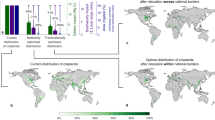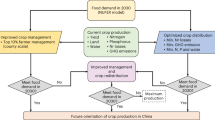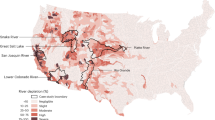Abstract
Growing demand for agricultural commodities for food, fuel and other uses is expected to be met through an intensification of production on lands that are currently under cultivation. Intensification typically entails investments in modern technology — such as irrigation or fertilizers — and increases in cropping frequency in regions suitable for multiple growing seasons. Here we combine a process-based crop water model with maps of spatially interpolated yields for 14 major food crops to identify potential differences in food production and water use between current and optimized crop distributions. We find that the current distribution of crops around the world neither attains maximum production nor minimum water use. We identify possible alternative configurations of the agricultural landscape that, by reshaping the global distribution of crops within current rainfed and irrigated croplands based on total water consumption, would feed an additional 825 million people while reducing the consumptive use of rainwater and irrigation water by 14% and 12%, respectively. Such an optimization process does not entail a loss of crop diversity, cropland expansion or impacts on nutrient and feed availability. It also does not necessarily invoke massive investments in modern technology that in many regions would require a switch from smallholder farming to large-scale commercial agriculture with important impacts on rural livelihoods.
This is a preview of subscription content, access via your institution
Access options
Access Nature and 54 other Nature Portfolio journals
Get Nature+, our best-value online-access subscription
$29.99 / 30 days
cancel any time
Subscribe to this journal
Receive 12 print issues and online access
$259.00 per year
only $21.58 per issue
Buy this article
- Purchase on Springer Link
- Instant access to full article PDF
Prices may be subject to local taxes which are calculated during checkout




Similar content being viewed by others
Change history
09 November 2017
Owing to a technical error, this Article was published a day later than stated. The correct date of publication is 7 November 2017; all versions of the Article have now been corrected accordingly.
References
Wackernagel, M. et al. Tracking the ecological overshoot of the human economy. Proc. Natl Acad. Sci. USA 99, 9266–9271 (2002).
Hoekstra, A. Y. & Wiedmann, T. O. Humanity’s unsustainable environmental footprint. Science 344, 1114–1117 (2014).
Steffen, W. et al. Planetary boundaries: Guiding human development on a changing planet. Science 347, 736 (2015).
Mueller, N. D. et al. Closing yield gaps through nutrient and water management. Nature 490, 254–257 (2012).
Ray, D. K. & Foley, J. A. Increasing global crop harvest frequency: recent trends and future directions. Environ. Res. Lett. 8, 044041 (2013).
Davis, K. F., D’Odorico, P. & Rulli, M. C. Moderating diets to feed the future. Earth Future 2, 559–565 (2014).
Davis, K. F. et al. Water limits to closing yield gaps. Adv. Water Res. 99, 67–75 (2017).
Davis, K. F. et al. Meeting future food demand with current agricultural resources. Glob. Environ. Change 39, 125–132 (2016).
van Ittersum, M. K. et al. Can sub-Saharan Africa feed itself? Proc. Natl Acad. Sci. USA 113, 14964–14969 (2016).
Porkka, M., Gerten, D., Schaphoff, S., Siebert, S. & Kummu, M. Causes and trends of water scarcity in food production. Environ. Res. Lett. 11, 015001 (2016).
Munia, H. et al. Water stress in global transboundary river basins: significance of upstream water use on downstream stress. Environ. Res. Lett. 11, 014002 (2016).
Rodell, M., Velicogna, I. & Famiglietti, J. S. Satellite-based estimates of groundwater depletion in India. Nature 460, 999–1002 (2009).
Famiglietti, J. S. The global groundwater crisis. Nat. Clim. Change 4, 945–948 (2014).
Rulli, M. C., Bellomi, D., Cazzoli, A., De Carolis, G. & D’Odorico, P. The water-land-food nexus of first-generation biofuels. Sci. Rep. 6, 22521 (2016).
Hoekstra, A. Y. & Mekonnen, M. M. The water footprint of humanity. Proc. Natl Acad. Sci. USA 109, 3232–3237 (2012).
Hoekstra, A. Y., Mekonnen, M. M., Chapagain, A. K., Mathews, R. E. & Richter, B. D. Global monthly water scarcity: blue water footprints versus blue water availability. PLoS ONE 7, e32688 (2012).
Brauman, K. A., Richter, B. D., Postel, S., Malsy, M. & Flörke, M. Water depletion: An improved metric for incorporating seasonal and dry-year water scarcity into water risk assessments. Elementa 4, 000083 (2016).
Elliot, J. et al. Constraints and potentials of future irrigation water availability on agricultural production under climate change. Proc. Natl Acad. Sci. USA 111, 3239–3244 (2014).
Wada, Y., Gleeson, T. & Esnault, L. Wedge approach to water stress. Nat. Geosci. 7, 615–617 (2014).
Tarjuelo, J. M., de Juan, J. A., Valiente, M. & García, P. Model for optimal cropping patterns within the farm based on crop water production functions and irrigation uniformity II: a case study of irrigation scheduling in Albacete, Spain. Agric. Water Manag. 31, 145–163 (1996).
Cooley, H., Christian-Smith, J. & Gleick, P. More with Less: Agricultural Water Conservation and Efficiency in California – A Special Focus on the Delta (Pacific Institute, Oakland, 2008).
Devineni, N., Perveen, S. & Lall, U. Shifting Crops, Saving Water (Columbia Water Center, The Earth Institute, 2011).
Brauman, K. A., Siebert, S. & Foley, J. A. Improvements in crop water productivity increase water sustainability and food security—a global analysis. Environ. Res. Lett. 8, 024030 (2013).
Jägermeyr, J. et al. Water savings potentials of irrigation systems: global simulation of processes and linkages. Hydrol. Earth. Syst. Sci. 19, 3073–3091 (2015).
Jalava, M., Kummu, M., Porkka, M., Siebert, S. & Varis, O. Diet change—a solution to reduce water use? Environ. Res. Lett. 9, 091003 (2014).
Kummu, M. et al. Lost food, wasted resources: global food supply chain losses and their impacts on freshwater, cropland, and fertiliser use. Sci. Tot. Environ. 438, 477–489 (2012).
Poff, N. L. et al. The ecological limits of hydrologic alteration (ELOHA): a new framework for developing regional environmental flow standards. Freshwat. Biol. 55, 147–170 (2009).
Wada, Y. et al. Global depletion of groundwater resources. Geophys. Res. Lett. 37, L20402 (2010).
Suweis, S., Carr, J. A., Maritan, A., Rinaldo, A. & D’Odorico, P. Resilience and reactivity of global food security. Proc. Natl Acad. Sci. USA 112, 6902–6907 (2015).
Gephart, J. A. et al. The environmental cost of subsistence: Optimizing diets to minimize footprints. Sci. Tot. Environ. 553, 120–127 (2016).
Phalan, B. et al. How can higher-yield farming help to spare nature? Science 351, 450–451 (2016).
Tilman, D. & Clark, M. Global diets link environmental sustainability and human health. Nature 515, 518–522 (2014).
Walker, B. & Salt, D. Resilience Thinking (Island, Washington DC, 2006).
Jägermeyr, J. et al. Integrated crop water management might sustainably halve the global food gap. Environ. Res. Lett. 11, 025002 (2016).
FAOSTAT Database (FAO, accessed 3 December 2016); http://www.fao.org/faostat.
Global Agro‐ecological Zones (GAEZ) v3.0 (IIASA/FAO, 2012).
Rulli, M. C. & D’Odorico, P. Food appropriation through large scale land acquisitions. Environ. Res. Lett. 9, 064030 (2014).
Smith, M. R., Micha, R., Golden, C. D., Mozaffarian, D. & Myers, S. S. Global Expanded Nutrient Supply (GENuS) Model: A new method for estimating the global dietary supply of nutrients. PLoS ONE 11, e0146976 (2016).
New, M., Lister, D., Hulme, M. & Makin, I. A high-resolution data set of surface climate over global land areas. Clim. Res. 21, 1–25 (2002).
Mekonnen, M. M. & Hoekstra, A. Y. The green, blue and grey water footprint of crops and derived crop products. Hydrol. Earth Syst. Sci. 15, 1577–1600 (2011).
Kottek, M., Grieser, J., Beck, C., Rudolf, B. & Rubel, F. World map of the Köppen-Geiger climate classification updated. Meteorol. Zeit. 15, 259–263 (2006).
Harmonized World Soil Database v.1.2 (FAO/IIASA, 2012).
Global Map of Monthly Reference Evapotranspiration – 10 Arc Minutes (FAO, accessed 18 April 2017).
Allen, R.G., Pereira, L.S., Raes, D. & Smith, M. Crop Evapotranspiration – Guidelines for Computing Crop Water Requirements Irrigation and Drainage Paper 56 (FAO, 1998).
Siebert, S. & Döll, P. Quantifying blue and green virtual water contents in global crop production as well as potential production losses without irrigation. J. Hydrol. 384, 198–207 (2010).
Hoogeveen, J., Faurès, J.-M., Peiser, L., Burke, J. & van de Giesen, N. GlobWat – a global water balance model to assess water use in irrigated agriculture. Hydrol. Earth Syst. Sci. 19, 3829–3844 (2015).
Wilks, D. S. & Wilby, R. L. The weather generation game: a review of stochastic weather models. Prog. Phys. Geogr. 23, 329–357 (1999).
Soil Conservation Service A Method for Estimating Volume and Rate of Runoff in Small Watersheds Report No. SCS-TP-149 (US Department of Agriculture, 1968).
Tuninetti, M., Tamea, S., D’Odorico, P., Laio, F. & Ridolfi, L. Global sensitivity of high-resolution estimates of crop water footprint. Water Resour. Res. 51, 8257–8272 (2015).
How Spline with Barriers Works (Environmental Systems Research Institute, 2017): http://desktop.arcgis.com/en/arcmap/10.3/tools/spatial-analyst-toolbox/how-spline-with-barriers-works.htm.
Acknowledgements
We thank M. R. Smith for providing information on crop nutrient content. We thank J. Gephart for her useful input regarding optimization approach. This work was supported by The Nature Conservancy’s NatureNet Science Fellows programme.
Author information
Authors and Affiliations
Contributions
K.F.D., A.S., M.C.R. and P.D. designed the experiment. K.F.D. and A.S. performed the analysis. K.F.D., M.C.R. and P.D. wrote the paper.
Corresponding author
Ethics declarations
Competing interests
The authors declare no competing financial interests.
Additional information
Publisher’s note: Springer Nature remains neutral with regard to jurisdictional claims in published maps and institutional affiliations.
A correction to this article is available online at https://doi.org/10.1038/s41561-017-0021-4.
Electronic supplementary material
Supplementary Information
Supplementary Figures
Supplementary Information
Supplementary Tables
Rights and permissions
About this article
Cite this article
Davis, K.F., Rulli, M.C., Seveso, A. et al. Increased food production and reduced water use through optimized crop distribution. Nature Geosci 10, 919–924 (2017). https://doi.org/10.1038/s41561-017-0004-5
Received:
Accepted:
Published:
Issue Date:
DOI: https://doi.org/10.1038/s41561-017-0004-5
This article is cited by
-
A temporal analysis of the consequences of the drought regime on the water footprint of agriculture in the Guadalupe Valley, Mexico
Scientific Reports (2024)
-
Half of twenty-first century global irrigation expansion has been in water-stressed regions
Nature Water (2024)
-
Research progress in assessment and strategies for sustainable food system within planetary boundaries
Science China Earth Sciences (2024)
-
Efficient agricultural practices in Africa reduce crop water footprint despite climate change, but rely on blue water resources
Communications Earth & Environment (2023)
-
The food-water-energy nexus and green roofs in Sao Jose dos Campos, Brazil, and Johannesburg, South Africa
npj Urban Sustainability (2023)



